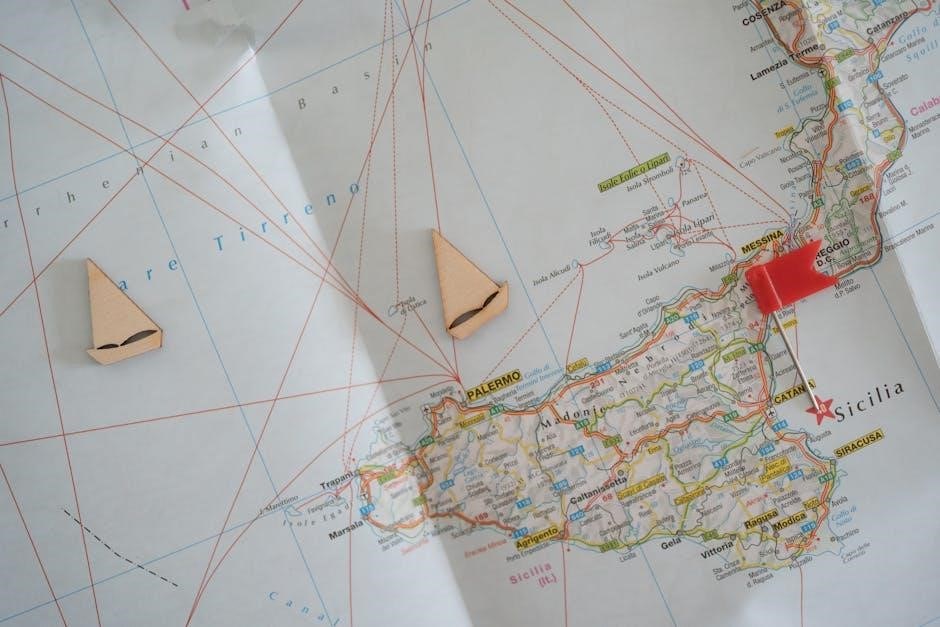Cartomancy is an ancient practice of gaining mystical insights through cards, offering a popular form of divination to reveal past events, understand the present, and foresee the future.
1.1 What is Cartomancy?
Cartomancy is the practice of divination using a deck of cards, typically a standard 52-card deck, to gain insights into the past, present, and future. It involves interpreting the symbolic meanings of the cards, which are believed to reflect various aspects of life, such as emotions, events, and decisions. Unlike tarot, which uses a specialized deck, cartomancy relies on ordinary playing cards, making it a more accessible and straightforward method of fortune-telling. The practice is rooted in intuition and the belief that the cards can reveal hidden truths and guide individuals toward understanding their circumstances and making informed choices. Cartomancy is often seen as a structured yet flexible way to explore life’s mysteries and seek guidance.
1.2 Brief History and Evolution
Cartomancy, the art of divination using playing cards, has a rich and evolving history. Originating in 18th-century Europe, it emerged as a simpler alternative to tarot, utilizing a standard 52-card deck. Over time, cartomancy spread globally, adapting to various cultural influences and gaining popularity for its accessibility. Unlike tarot, it doesn’t require specialized cards, making it a preferred method for many. Today, cartomancy continues to grow, with modern practitioners using both traditional techniques and digital tools. Its enduring appeal lies in its intuitive approach, offering insights into life’s mysteries for those seeking guidance.
1.3 How Cartomancy Differs from Tarot
Cartomancy and tarot, while both forms of card-based divination, differ significantly. Cartomancy uses a standard 52-card playing deck, making it more accessible, whereas tarot employs a 78-card deck with intricate symbolism. Cartomancy is often seen as simpler, focusing on straightforward interpretations, while tarot delves deeper into complex themes and spiritual connections. The structure of cartomancy is more adaptable, allowing for diverse interpretations, whereas tarot follows established archetypes and meanings. Additionally, cartomancy tends to be more practical, often used for everyday guidance, while tarot is frequently associated with deeper, existential questions. These distinctions make cartomancy a preferred choice for beginners seeking a more intuitive approach to divination.

The Basics of Cartomancy
Cartomancy involves using a standard deck of 52 playing cards to uncover hidden truths and guide decision-making through intuitive interpretations of card meanings and combinations.
2.1 Understanding the Deck Structure
A standard cartomancy deck consists of 52 cards, divided into four suits: Hearts, Diamonds, Clubs, and Spades. Each suit contains 13 cards, including numbered cards (Ace through 10), face cards (Jack, Queen, King), and the Ace. Hearts are often linked to emotions and relationships, Diamonds to finances and material wealth, Clubs to friendships and community, and Spades to challenges and transformation. The court cards (Jack, Queen, King) represent individuals or energies, while numbered cards reflect specific situations or numerological influences. Understanding this structure is key to interpreting card meanings and combinations during a reading.
2.2 The Role of Suits in Cartomancy
In cartomancy, the four suits—Hearts, Diamonds, Clubs, and Spades—each carry distinct meanings tied to their elemental associations. Hearts, linked to Water, represent emotions, relationships, and intuition. Diamonds, associated with Fire, symbolize finances, ambitions, and material success. Clubs, connected to Air, reflect communication, friendships, and intellectual pursuits. Spades, tied to Earth, signify challenges, transformations, and practical matters. These suits provide a framework for interpreting card meanings, allowing practitioners to connect specific aspects of life with the cards. For example, a Heart card might indicate a romantic issue, while a Spade could point to an obstacle. Understanding the role of suits enhances the depth and accuracy of cartomancy readings, offering a structured approach to divination.
2.3 The Significance of Court Cards
Court cards in cartomancy hold profound symbolic meanings, representing individuals, personalities, or specific energies. The King, Queen, Knight, and Jack (or sometimes referred to as the Knave) each embody unique roles. Kings symbolize authority, leadership, and mastery, often indicating a dominant figure or a significant decision. Queens represent nurturing, intuition, and emotional depth, reflecting feminine wisdom or a caretaking presence. Knights are associated with action, change, and sometimes conflict, suggesting movement or a catalyst for events. Jacks, or Pages, often signify new beginnings, messages, or youthful energy. These cards can also mirror aspects of the querent’s personality or external influences. Interpreting court cards requires a blend of intuition and understanding their archetypal roles, making them powerful tools in cartomancy readings for gaining insights into people and situations.

Cartomancy vs. Tarot
Cartomancy and tarot share similarities but differ in deck structure and symbolism. Tarot decks have 78 cards with detailed imagery, while cartomancy uses a standard 52-card deck, making it more accessible for beginners. Both practices aim to provide insights and guidance, but cartomancy is often seen as more straightforward and easier to learn. This distinction makes cartomancy a popular choice for those new to card divination, offering a simpler yet effective method for self-discovery and foresight.
3.1 Similarities Between Cartomancy and Tarot
Cartomancy and tarot share the common goal of using cards to gain insights into the past, present, and future. Both practices rely on the reader’s intuition and interpretation of card meanings, though tarot decks are larger and more symbolic. In cartomancy, a standard 52-card deck is used, while tarot has 78 cards with detailed imagery. Despite these differences, both methods involve card spreads and the interpretation of card positions. Elemental associations, such as linking suits to elements like water, fire, earth, and air, are present in both traditions. Both practices also emphasize the importance of connecting with the cards on a deeper level to uncover hidden truths and guide decision-making. These parallels highlight their shared roots in divination and self-discovery.
3.2 Key Differences in Practices
While both cartomancy and tarot use cards for divination, their practices differ significantly. Tarot employs a 78-card deck with 22 major arcana cards and 56 minor arcana cards, each carrying specific symbolism. In contrast, cartomancy uses a standard 52-card playing deck, relying more on traditional card meanings and less on intricate imagery. Tarot readings often follow structured spreads like the Celtic Cross, whereas cartomancy tends to use simpler layouts. Additionally, tarot places greater emphasis on the connection between cards and esoteric knowledge, while cartomancy focuses on practical, everyday interpretations. Tarot is also more commonly used for deeper, spiritual inquiries, whereas cartomancy is often preferred for straightforward, situational guidance. These distinctions make each method unique, catering to different preferences and needs in divination.
3.3 Which is More Accessible for Beginners?

Cartomancy is generally more accessible for beginners due to its use of a standard 52-card deck, which is widely available and familiar to most people. The meanings of playing cards are often more straightforward compared to tarot, requiring less study of complex symbolism. Additionally, cartomancy practices tend to be simpler, with fewer structured spreads and rituals. Tarot, while powerful, involves a 78-card deck with intricate imagery and deeper esoteric connections, which can be overwhelming for newcomers. Cartomancy’s practical and intuitive approach makes it easier for beginners to grasp basic techniques quickly, allowing them to perform meaningful readings without extensive prior knowledge or preparation.
![]()
A Beginner’s Guide to Cartomancy
Start by understanding the deck structure and card meanings. Practice simple spreads and trust your intuition. Begin with daily guidance to enhance your skills gradually.
4.1 Choosing the Right Deck
Choosing the right deck is essential for effective cartomancy. Select a deck that resonates with you personally, whether it’s a traditional playing card deck or a specialized cartomancy set. Consider the design, as visually appealing cards can enhance your connection. Standard playing cards are ideal for beginners, offering a familiar structure with 52 cards divided into four suits. Trust your intuition when picking a deck, as it will serve as your primary tool for readings. Starting with a basic deck allows you to master the fundamentals before exploring more complex or themed options. Cleansing and dedicating your deck beforehand can also strengthen your bond with the cards.
- Opt for a deck that feels comfortable in your hands.
- Begin with a standard playing card deck for simplicity.
- Trust your intuition when selecting your first deck.
4.2 Understanding Card Meanings
Understanding card meanings is fundamental to mastering cartomancy. Each card carries specific symbolism, with suits and numbers offering unique insights. Hearts, associated with water, represent emotions and relationships, while diamonds, linked to earth, signify material wealth and practical matters. Clubs, tied to fire, reflect creativity and passion, and spades, connected to air, symbolize logic and challenges. Numbered cards often denote specific events or timelines, while court cards represent individuals or roles in a situation. Reversed cards can alter meanings, suggesting blockages or opposites. Learning these interpretations allows for deeper readings, helping you tap into the underlying messages of the cards and apply them to real-life situations. Starting with a basic meanings chart can simplify the learning process and enhance your intuition over time.
- Hearts: Emotions, relationships, and personal matters.
- Diamonds: Financial affairs and material success.
- Clubs: Creativity, inspiration, and new opportunities.
- Spades: Challenges, logic, and spiritual growth.
4.3 Preparing for Your First Reading
Preparing for your first cartomancy reading involves both mental and physical readiness. Begin by creating a peaceful environment, free from distractions, to focus your mind and energy. Center yourself through meditation or deep breathing to enhance intuition. Shuffle the deck with a clear intention, ensuring each card aligns with your query. Some practitioners believe in cleansing the cards with incense or placing them under a crystal to purify their energy. Trust your instincts and interpret the cards’ symbolism, recognizing that each card reflects aspects of the past, present, or future. Start with simple questions and remain open to the insights, allowing your connection to the cards to grow naturally over time.
- Create a calm and focused atmosphere.
- Shuffle the cards with intention and clarity.
- Trust your intuition and interpret symbolism.
- Begin with simple, clear questions.
4.4 Simple Spreads to Start With
Mastering simple spreads is essential for beginners in cartomancy. The Three-Card Spread is a popular choice, representing the past, present, and future. It provides clarity on current situations and potential outcomes. Another easy spread is the Celtic Cross, which offers deeper insights by exploring challenges, past influences, and future outcomes. For quick answers, the Yes/No Spread is ideal, using card positions to indicate positive or negative responses. These spreads are straightforward, helping you build confidence and intuition as you progress in your cartomancy journey. Start with these foundational layouts to gain a solid understanding of how card positions and combinations can reveal meaningful insights;
- Three-Card Spread: Past, present, and future.
- Celtic Cross: Explores challenges and influences.
- Yes/No Spread: Simplifies decision-making.

Advanced Cartomancy Techniques
Advanced cartomancy involves mastering reversed cards, timing interpretations, and complex spreads. These techniques enhance accuracy and depth, allowing for nuanced and detailed readings.
- Reading reversed cards for opposite meanings.
- Understanding timing in card interpretations.
- Exploring advanced card combinations.
5.1 Reading Reversed Cards
Reversed cards in cartomancy add complexity to readings, often indicating blocked energies or opposing interpretations. They can signify delays, challenges, or the need to reevaluate circumstances. For instance, a reversed Heart suit card might suggest emotional barriers, while a reversed Ace of Spades could indicate missed opportunities. To interpret them effectively, consider the card’s upright meaning and how its reversal might alter the context. Reversed cards encourage deeper reflection and highlight areas where extra attention or adjustment is needed. By understanding these nuances, practitioners can offer more insightful and balanced readings. This skill enhances the overall accuracy and depth of cartomancy sessions.
5.2 Understanding Card Combinations
Card combinations in cartomancy enhance the depth of a reading by revealing interconnected themes and influences. When multiple cards appear in a spread, their meanings can blend, creating a nuanced narrative. For example, the combination of a heart suit card with a court card might emphasize emotional relationships or personal interactions. Elemental associations, such as water (hearts) and fire (diamonds), can clash or harmonize, influencing the interpretation. Practitioners must consider how cards interact, as their positions and relationships often uncover hidden dynamics. Mastering card combinations requires practice, intuition, and a deep understanding of individual card meanings. This advanced skill allows for richer, more layered insights, making readings more comprehensive and meaningful.
5.3 Timing in Cartomancy Readings
Timing in cartomancy involves interpreting when events may occur, adding depth to a reading. While not always exact, cards can suggest timeframes by associating suits with elements: hearts for days, diamonds for weeks, clubs for months, and spades for seasons or years. Number cards often represent weeks or months, while court cards may signify longer periods. For example, the 3 of Hearts could indicate three days, while the King of Spades might suggest a year or a significant life phase. Timing remains approximate, as cartomancy relies on intuition and context. Practitioners develop their own systems, blending card meanings with personal insight to guide clients through time-related queries, enhancing the practical value of a reading.

5.4 Using Cartomancy for Specific Questions
Cartomancy can be effectively used to address specific questions, offering guidance on various aspects of life. Whether exploring relationships, career paths, or financial decisions, the cards provide insights tailored to the query. Practitioners often use focused spreads or draw single cards to clarify intentions. For example, asking about a relationship might involve examining the interaction between hearts and cups, while career questions may emphasize diamonds and spades. The clarity of the question enhances the reading’s accuracy, allowing deeper exploration of the situation. While cartomancy isn’t a predictive science, it serves as a powerful tool for self-reflection and decision-making, helping individuals navigate life’s complexities with greater confidence and intuition.

The Spiritual and Psychological Aspects
Cartomancy bridges the spiritual and psychological, fostering intuition, self-awareness, and emotional healing. It helps individuals connect with their inner world, promoting balance and deeper understanding of life’s complexities.
6.1 The Role of Intuition in Cartomancy
Intuition plays a pivotal role in cartomancy, guiding practitioners to interpret card meanings beyond their literal definitions. It allows readers to connect with the querent’s energy, uncovering hidden patterns and emotions. By tuning into their inner voice, cartomancers can provide deeper, more personalized insights, making readings more meaningful and accurate. The Internet highlights that intuition enhances the connection between the cards and the situation, enabling practitioners to navigate complex scenarios with empathy and clarity. This subtle yet powerful skill is essential for mastering the art of cartomancy, transforming it from a mere card game into a profound tool for self-discovery and guidance.
6.2 Symbolism and Hidden Meanings
Cartomancy deeply relies on the symbolism embedded in playing cards, where each suit and card carries specific meanings. Hearts often represent emotions and relationships, while diamonds symbolize material wealth and practical matters. Clubs are linked to friendships and community, and spades to challenges and transformation. The deck’s structure, with 52 cards, mirrors life’s cycles, offering insights into various aspects of human experience. Hidden meanings can be uncovered by interpreting elemental associations, card combinations, and their positions in spreads. This layered symbolism allows practitioners to delve beyond surface-level interpretations, revealing deeper truths about situations, emotions, and future possibilities.
6.3 Connecting with the Cards on a Deeper Level
Connecting with the cards on a deeper level involves cultivating intuition and personal resonance. Practitioners often meditate with specific cards, journal their interpretations, and explore historical symbolism. Trusting one’s instincts is crucial, as cartomancy thrives on personal connection. Over time, this bond enhances accuracy and meaningful insights, allowing practitioners to unlock the cards’ hidden wisdom and apply it to real-life situations.

Practical Applications of Cartomancy
Cartomancy offers versatile tools for daily life, helping users make decisions, navigate challenges, and gain clarity. It empowers individuals to seek guidance and uncover hidden truths simply.

7.1 Using Cartomancy for Daily Guidance
Cartomancy serves as a powerful tool for navigating daily life, offering insights into decisions, emotions, and challenges. By using a standard deck, individuals can gain clarity on immediate concerns. Each suit—Hearts, Diamonds, Clubs, and Spades—represents elements like emotions, finances, friendships, and challenges, providing a structured framework for interpretation. Daily readings can be as simple as drawing a single card for instant guidance or using spreads like the Three-Card Spread for past, present, and future perspectives. This practice fosters self-awareness and aids in making informed choices. Over time, cartomancy becomes a trusted companion for personal growth and problem-solving, helping users align with their goals and aspirations effectively.
7.2 Cartomancy in Relationship Readings
Cartomancy offers profound insights into relationship dynamics, helping individuals understand emotional connections, conflicts, and future prospects. By interpreting the symbolism of playing cards, readers can uncover hidden tensions or potential harmonies. Spreads like the Three-Card Spread (past, present, future) or the Celtic Cross provide detailed overviews of relationship statuses. Hearts often symbolize emotional bonds, while Diamonds may indicate shared goals or financial ties. Spades can reveal challenges, and Clubs may highlight friendships or alliances. Cartomancy also helps predict outcomes, such as the Ace of Hearts signaling new love or the King of Spades indicating unresolved conflicts. Regular use of cartomancy fosters empathy and clarity, guiding individuals toward healthier, more fulfilling connections.
7.3 Applying Cartomancy to Career and Finance
Cartomancy provides valuable insights into career and financial matters, helping individuals make informed decisions. The suit of Diamonds often represents financial success, while Clubs may signify business opportunities or collaborations. Hearts can indicate career passions, and Spades may reveal challenges or obstacles. Specific cards, like the Ace of Diamonds, suggest new financial opportunities, while the 5 of Spades may warn of setbacks. By interpreting these symbols, cartomancy offers guidance on career paths, investment decisions, and achieving financial stability. Regular readings can also help individuals align their professional goals with their personal values, fostering a balanced and prosperous life. This makes cartomancy a powerful tool for navigating career and financial landscapes with clarity and confidence.
Mastering cartomancy requires practice and dedication. Explore books like Cartomancy: The Art of Fortune Telling by Sophia Buckland and online guides for deeper understanding and refinement of skills.
8.1 Final Thoughts on Mastering Cartomancy
Mastering cartomancy is a journey of patience, intuition, and practice. As you progress, remember that the cards are tools to connect with your inner wisdom and the world around you. Begin with simple spreads and gradually explore more complex techniques. Trust your instincts, as intuition plays a vital role in interpreting card meanings. Regular practice will deepen your understanding and enhance your ability to provide meaningful readings. Whether for personal growth or helping others, cartomancy offers a versatile and powerful method of self-discovery. Embrace the process, stay open to learning, and enjoy the transformative experience of working with the cards. Over time, you’ll find cartomancy becoming an integral part of your spiritual and practical life.
8.2 Recommended Reading and Resources
For a deeper dive into cartomancy, explore books like Cartomancy ⎯ The Art of Fortune Telling with Playing Cards by Sophia Buckland, offering a comprehensive guide for beginners. Another excellent resource is Fifty-four Devils, a detailed guide to card divination. Online, seek out PDF guides that explain elemental associations and card meanings, such as those linking Hearts to Water and Diamonds to Fire. Additionally, websites like Tarot Learning and Cartomancy 101 provide practical tips and step-by-step instructions. Join online communities and forums to connect with other practitioners and gain insights. These resources will help you refine your skills and expand your knowledge, whether you’re just starting or seeking advanced techniques.




Be the first to reply